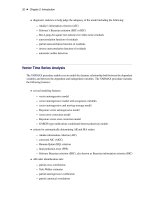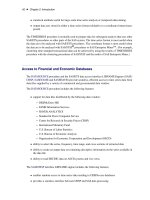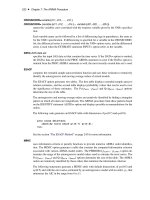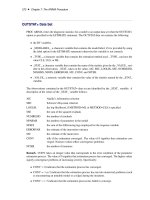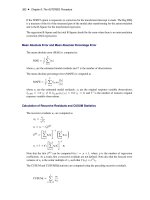SAS/ETS 9.22 User''''s Guide 23 pps
Bạn đang xem bản rút gọn của tài liệu. Xem và tải ngay bản đầy đủ của tài liệu tại đây (269.69 KB, 10 trang )
212 ✦ Chapter 7: The ARIMA Procedure
X
i;t
is the ith input time series or a difference of the ith input series at time t
k
i
is the pure time delay for the effect of the ith input series
!
i
.B/ is the numerator polynomial of the transfer function for the ith input series
ı
i
.B/ is the denominator polynomial of the transfer function for the ith input series.
The model can also be written more compactly as
W
t
D C
X
i
‰
i
.B/X
i;t
C n
t
where
‰
i
.B/
is the transfer function for the ith input series modeled as a ratio of the
!
and
ı
polynomials: ‰
i
.B/ D .!
i
.B/=ı
i
.B//B
k
i
n
t
is the noise series: n
t
D .Â.B/=.B//a
t
This model expresses the response series as a combination of past values of the random shocks
and past values of other input series. The response series is also called the dependent series or
output series. An input time series is also referred to as an independent series or a predictor series.
Response variable, dependent variable, independent variable, or predictor variable are other terms
often used.
Notation for Factored Models
ARIMA models are sometimes expressed in a factored form. This means that the
,
Â
,
!
, or
ı
polynomials are expressed as products of simpler polynomials. For example, you could express the
pure ARIMA model as
W
t
D C
Â
1
.B/Â
2
.B/
1
.B/
2
.B/
a
t
where
1
.B/
2
.B/ D .B/ and Â
1
.B/Â
2
.B/ D Â.B/.
When an ARIMA model is expressed in factored form, the order of the model is usually expressed
by using a factored notation also. The order of an ARIMA model expressed as the product of two
factors is denoted as ARIMA(p,d,q)(P,D,Q).
Notation for Seasonal Models
ARIMA models for time series with regular seasonal fluctuations often use differencing operators
and autoregressive and moving-average parameters at lags that are multiples of the length of the
seasonal cycle. When all the terms in an ARIMA model factor refer to lags that are a multiple of a
constant s, the constant is factored out and suffixed to the ARIMA(p,d,q ) notation.
Thus, the general notation for the order of a seasonal ARIMA model with both seasonal and
nonseasonal factors is ARIMA(p,d,q)
(P,D,Q)
s
. The term (p,d,q) gives the order of the nonseasonal
part of the ARIMA model; the term (P,D,Q)
s
gives the order of the seasonal part. The value of s is
Stationarity ✦ 213
the number of observations in a seasonal cycle: 12 for monthly series, 4 for quarterly series, 7 for
daily series with day-of-week effects, and so forth.
For example, the notation ARIMA(0,1,2)
(0,1,1)
12
describes a seasonal ARIMA model for monthly
data with the following mathematical form:
.1 B/.1 B
12
/Y
t
D C .1 Â
1;1
B Â
1;2
B
2
/.1 Â
2;1
B
12
/a
t
Stationarity
The noise (or residual) series for an ARMA model must be stationary, which means that both the
expected values of the series and its autocovariance function are independent of time.
The standard way to check for nonstationarity is to plot the series and its autocorrelation function.
You can visually examine a graph of the series over time to see if it has a visible trend or if its
variability changes noticeably over time. If the series is nonstationary, its autocorrelation function
will usually decay slowly.
Another way of checking for stationarity is to use the stationarity tests described in the section
“Stationarity Tests” on page 250.
Most time series are nonstationary and must be transformed to a stationary series before the ARIMA
modeling process can proceed. If the series has a nonstationary variance, taking the log of the series
can help. You can compute the log values in a DATA step and then analyze the log values with PROC
ARIMA.
If the series has a trend over time, seasonality, or some other nonstationary pattern, the usual solution
is to take the difference of the series from one period to the next and then analyze this differenced
series. Sometimes a series might need to be differenced more than once or differenced at lags greater
than one period. (If the trend or seasonal effects are very regular, the introduction of explanatory
variables can be an appropriate alternative to differencing.)
Differencing
Differencing of the response series is specified with the VAR= option of the IDENTIFY statement
by placing a list of differencing periods in parentheses after the variable name. For example, to take
a simple first difference of the series SALES, use the statement
identify var=sales(1);
In this example, the change in SALES from one period to the next is analyzed.
A deterministic seasonal pattern also causes the series to be nonstationary, since the expected value
of the series is not the same for all time periods but is higher or lower depending on the season. When
214 ✦ Chapter 7: The ARIMA Procedure
the series has a seasonal pattern, you might want to difference the series at a lag that corresponds to
the length of the seasonal cycle. For example, if SALES is a monthly series, the statement
identify var=sales(12);
takes a seasonal difference of SALES, so that the series analyzed is the change in SALES from its
value in the same month one year ago.
To take a second difference, add another differencing period to the list. For example, the following
statement takes the second difference of SALES:
identify var=sales(1,1);
That is, SALES is differenced once at lag 1 and then differenced again, also at lag 1. The statement
identify var=sales(2);
creates a 2-span difference—that is, current period SALES minus SALES from two periods ago. The
statement
identify var=sales(1,12);
takes a second-order difference of SALES, so that the series analyzed is the difference between the
current period-to-period change in SALES and the change 12 periods ago. You might want to do this
if the series had both a trend over time and a seasonal pattern.
There is no limit to the order of differencing and the degree of lagging for each difference.
Differencing not only affects the series used for the IDENTIFY statement output but also applies to
any following ESTIMATE and FORECAST statements. ESTIMATE statements fit ARMA models
to the differenced series. FORECAST statements forecast the differences and automatically sum
these differences back to undo the differencing operation specified by the IDENTIFY statement, thus
producing the final forecast result.
Differencing of input series is specified by the CROSSCORR= option and works just like differencing
of the response series. For example, the statement
identify var=y(1) crosscorr=(x1(1) x2(1));
takes the first difference of Y, the first difference of X1, and the first difference of X2. Whenever X1
and X2 are used in INPUT= options in following ESTIMATE statements, these names refer to the
differenced series.
Subset, Seasonal, and Factored ARMA Models ✦ 215
Subset, Seasonal, and Factored ARMA Models
The simplest way to specify an ARMA model is to give the order of the AR and MA parts with the
P= and Q= options. When you do this, the model has parameters for the AR and MA parts for all
lags through the order specified. However, you can control the form of the ARIMA model exactly as
shown in the following section.
Subset Models
You can control which lags have parameters by specifying the P= or Q= option as a list of lags in
parentheses. A model that includes parameters for only some lags is sometimes called a subset or
additive model. For example, consider the following two ESTIMATE statements:
identify var=sales;
estimate p=4;
estimate p=(1 4);
Both specify AR(4) models, but the first has parameters for lags 1, 2, 3, and 4, while the second has
parameters for lags 1 and 4, with the coefficients for lags 2 and 3 constrained to 0. The mathematical
form of the autoregressive models produced by these two specifications is shown in Table 7.1.
Table 7.1 Saturated versus Subset Models
Option Autoregressive Operator
P=4 .1
1
B
2
B
2
3
B
3
4
B
4
/
P=(1 4) .1
1
B
4
B
4
/
Seasonal Models
One particularly useful kind of subset model is a seasonal model. When the response series has a
seasonal pattern, the values of the series at the same time of year in previous years can be important
for modeling the series. For example, if the series SALES is observed monthly, the statements
identify var=sales;
estimate p=(12);
model SALES as an average value plus some fraction of its deviation from this average value a year
ago, plus a random error. Although this is an AR(12) model, it has only one autoregressive parameter.
216 ✦ Chapter 7: The ARIMA Procedure
Factored Models
A factored model (also referred to as a multiplicative model) represents the ARIMA model as a
product of simpler ARIMA models. For example, you might model SALES as a combination of an
AR(1) process that reflects short term dependencies and an AR(12) model that reflects the seasonal
pattern.
It might seem that the way to do this is with the option P=(1 12), but the AR(1) process also operates
in past years; you really need autoregressive parameters at lags 1, 12, and 13. You can specify
a subset model with separate parameters at these lags, or you can specify a factored model that
represents the model as the product of an AR(1) model and an AR(12) model. Consider the following
two ESTIMATE statements:
identify var=sales;
estimate p=(1 12 13);
estimate p=(1)(12);
The mathematical form of the autoregressive models produced by these two specifications are shown
in Table 7.2.
Table 7.2 Subset versus Factored Models
Option Autoregressive Operator
P=(1 12 13) .1
1
B
12
B
12
13
B
13
/
P=(1)(12) .1
1
B/.1
12
B
12
/
Both models fit by these two ESTIMATE statements predict SALES from its values 1, 12, and 13
periods ago, but they use different parameterizations. The first model has three parameters, whose
meanings may be hard to interpret.
The factored specification P=(1)(12) represents the model as the product of two different AR models.
It has only two parameters: one that corresponds to recent effects and one that represents seasonal
effects. Thus the factored model is more parsimonious, and its parameter estimates are more clearly
interpretable.
Input Variables and Regression with ARMA Errors
In addition to past values of the response series and past errors, you can also model the response
series using the current and past values of other series, called input series.
Several different names are used to describe ARIMA models with input series. Transfer function
model, intervention model, interrupted time series model, regression model with ARMA errors,
Box-Tiao model, and ARIMAX model are all different names for ARIMA models with input series.
Pankratz (1991) refers to these models as dynamic regression models.
Input Variables and Regression with ARMA Errors ✦ 217
Using Input Series
To use input series, list the input series in a CROSSCORR= option on the IDENTIFY statement and
specify how they enter the model with an INPUT= option on the ESTIMATE statement. For example,
you might use a series called PRICE to help model SALES, as shown in the following statements:
proc arima data=a;
identify var=sales crosscorr=price;
estimate input=price;
run;
This example performs a simple linear regression of SALES on PRICE; it produces the same results
as PROC REG or another SAS regression procedure. The mathematical form of the model estimated
by these statements is
Y
t
D C !
0
X
t
C a
t
The parameter estimates table for this example (using simulated data) is shown in Figure 7.20. The
intercept parameter is labeled MU. The regression coefficient for PRICE is labeled NUM1. (See the
section “Naming of Model Parameters” on page 259 for information about how parameters for input
series are named.)
Figure 7.20 Parameter Estimates Table for Regression Model
The ARIMA Procedure
Conditional Least Squares Estimation
Standard Approx
Parameter Estimate Error t Value Pr > |t| Lag Variable Shift
MU 199.83602 2.99463 66.73 <.0001 0 sales 0
NUM1 -9.99299 0.02885 -346.38 <.0001 0 price 0
Any number of input variables can be used in a model. For example, the following statements fit a
multiple regression of SALES on PRICE and INCOME:
proc arima data=a;
identify var=sales crosscorr=(price income);
estimate input=(price income);
run;
The mathematical form of the regression model estimated by these statements is
Y
t
D C !
1
X
1;t
C !
2
X
2;t
C a
t
218 ✦ Chapter 7: The ARIMA Procedure
Lagging and Differencing Input Series
You can also difference and lag the input series. For example, the following statements regress the
change in SALES on the change in PRICE lagged by one period. The difference of PRICE is specified
with the CROSSCORR= option and the lag of the change in PRICE is specified by the 1 $ in the
INPUT= option.
proc arima data=a;
identify var=sales(1) crosscorr=price(1);
estimate input=( 1 $ price );
run;
These statements estimate the model
.1 B/Y
t
D C !
0
.1 B/X
t1
C a
t
Regression with ARMA Errors
You can combine input series with ARMA models for the errors. For example, the following
statements regress SALES on INCOME and PRICE but with the error term of the regression model
(called the noise series in ARIMA modeling terminology) assumed to be an ARMA(1,1) process.
proc arima data=a;
identify var=sales crosscorr=(price income);
estimate p=1 q=1 input=(price income);
run;
These statements estimate the model
Y
t
D C !
1
X
1;t
C !
2
X
2;t
C
.1 Â
1
B/
.1
1
B/
a
t
Stationarity and Input Series
Note that the requirement of stationarity applies to the noise series. If there are no input variables,
the response series (after differencing and minus the mean term) and the noise series are the same.
However, if there are inputs, the noise series is the residual after the effect of the inputs is removed.
There is no requirement that the input series be stationary. If the inputs are nonstationary, the response
series will be nonstationary, even though the noise process might be stationary.
When nonstationary input series are used, you can fit the input variables first with no ARMA model
for the errors and then consider the stationarity of the residuals before identifying an ARMA model
for the noise part.
Intervention Models and Interrupted Time Series ✦ 219
Identifying Regression Models with ARMA Errors
Previous sections described the ARIMA modeling identification process that uses the autocorrelation
function plots produced by the IDENTIFY statement. This identification process does not apply
when the response series depends on input variables. This is because it is the noise process for
which you need to identify an ARIMA model, and when input series are involved the response series
adjusted for the mean is no longer an estimate of the noise series.
However, if the input series are independent of the noise series, you can use the residuals from the
regression model as an estimate of the noise series, then apply the ARIMA modeling identification
process to this residual series. This assumes that the noise process is stationary.
The PLOT option in the ESTIMATE statement produces similar plots for the model residuals as the
IDENTIFY statement produces for the response series. The PLOT option prints an autocorrelation
function plot, an inverse autocorrelation function plot, and a partial autocorrelation function plot for
the residual series. Note that if ODS Graphics is enabled, then the PLOT option is not needed and
these residual correlation plots are produced by default.
The following statements show how the PLOT option is used to identify the ARMA(1,1) model for
the noise process used in the preceding example of regression with ARMA errors:
proc arima data=a;
identify var=sales crosscorr=(price income) noprint;
estimate input=(price income) plot;
run;
estimate p=1 q=1 input=(price income);
run;
In this example, the IDENTIFY statement includes the NOPRINT option since the autocorrelation
plots for the response series are not useful when you know that the response series depends on input
series.
The first ESTIMATE statement fits the regression model with no model for the noise process. The
PLOT option produces plots of the autocorrelation function, inverse autocorrelation function, and
partial autocorrelation function for the residual series of the regression on PRICE and INCOME.
By examining the PLOT option output for the residual series, you verify that the residual series
is stationary and identify an ARMA(1,1) model for the noise process. The second ESTIMATE
statement fits the final model.
Although this discussion addresses regression models, the same remarks apply to identifying an
ARIMA model for the noise process in models that include input series with complex transfer
functions.
Intervention Models and Interrupted Time Series
One special kind of ARIMA model with input series is called an intervention model or interrupted
time series model. In an intervention model, the input series is an indicator variable that contains
220 ✦ Chapter 7: The ARIMA Procedure
discrete values that flag the occurrence of an event affecting the response series. This event is an
intervention in or an interruption of the normal evolution of the response time series, which, in the
absence of the intervention, is usually assumed to be a pure ARIMA process.
Intervention models can be used both to model and forecast the response series and also to analyze
the impact of the intervention. When the focus is on estimating the effect of the intervention, the
process is often called intervention analysis or interrupted time series analysis.
Impulse Interventions
The intervention can be a one-time event. For example, you might want to study the effect of a
short-term advertising campaign on the sales of a product. In this case, the input variable has the
value of 1 for the period during which the advertising campaign took place and the value 0 for all
other periods. Intervention variables of this kind are sometimes called impulse functions or pulse
functions.
Suppose that SALES is a monthly series, and a special advertising effort was made during the month
of March 1992. The following statements estimate the effect of this intervention by assuming
an ARMA(1,1) model for SALES. The model is specified just like the regression model, but the
intervention variable AD is constructed in the DATA step as a zero-one indicator for the month of the
advertising effort.
data a;
set a;
ad = (date = '1mar1992'd);
run;
proc arima data=a;
identify var=sales crosscorr=ad;
estimate p=1 q=1 input=ad;
run;
Continuing Interventions
Other interventions can be continuing, in which case the input variable flags periods before and after
the intervention. For example, you might want to study the effect of a change in tax rates on some
economic measure. Another example is a study of the effect of a change in speed limits on the rate
of traffic fatalities. In this case, the input variable has the value 1 after the new speed limit went into
effect and the value 0 before. Intervention variables of this kind are called step functions.
Another example is the effect of news on product demand. Suppose it was reported in July 1996
that consumption of the product prevents heart disease (or causes cancer), and SALES is consistently
higher (or lower) thereafter. The following statements model the effect of this news intervention:
data a;
set a;
news = (date >= '1jul1996'd);
run;
Rational Transfer Functions and Distributed Lag Models ✦ 221
proc arima data=a;
identify var=sales crosscorr=news;
estimate p=1 q=1 input=news;
run;
Interaction Effects
You can include any number of intervention variables in the model. Intervention variables can have
any pattern—impulse and continuing interventions are just two possible cases. You can mix discrete
valued intervention variables and continuous regressor variables in the same model.
You can also form interaction effects by multiplying input variables and including the product
variable as another input. Indeed, as long as the dependent measure is continuous and forms a regular
time series, you can use PROC ARIMA to fit any general linear model in conjunction with an ARMA
model for the error process by using input variables that correspond to the columns of the design
matrix of the linear model.
Rational Transfer Functions and Distributed Lag Models
How an input series enters the model is called its transfer function. Thus, ARIMA models with input
series are sometimes referred to as transfer function models.
In the preceding regression and intervention model examples, the transfer function is a single scale
parameter. However, you can also specify complex transfer functions composed of numerator and
denominator polynomials in the backshift operator. These transfer functions operate on the input
series in the same way that the ARMA specification operates on the error term.
Numerator Factors
For example, suppose you want to model the effect of PRICE on SALES as taking place gradually with
the impact distributed over several past lags of PRICE. This is illustrated by the following statements:
proc arima data=a;
identify var=sales crosscorr=price;
estimate input=( (1 2 3) price );
run;
These statements estimate the model
Y
t
D C .!
0
!
1
B !
2
B
2
!
3
B
3
/X
t
C a
t
This example models the effect of PRICE on SALES as a linear function of the current and three
most recent values of PRICE. It is equivalent to a multiple linear regression of SALES on PRICE,
LAG(PRICE), LAG2(PRICE), and LAG3(PRICE).
